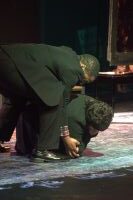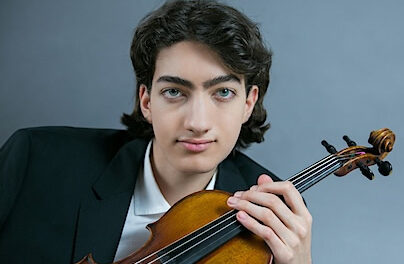The Sitkovetsky and Friends Chamber Series can always be counted upon for an interesting mix of artists and composers. The Recital Hall, furnished by the University of North Carolina Greensboro School of Music, is an ideal intimate venue for chamber music. The featured Masterworks Orchestra concerto soloist, principal violist Scott Rawls, was featured in a rare work by Charles Martin Loeffler (1861-1935) and the lighthearted septet by Ludwig van Beethoven (1720-1827). This concert was eagerly anticipated because of the Loeffler. I was impressed by A Pagan Poem, Op. 14, which I had heard on an old LP recording conducted by Leopold Stokowski (reissued on EMI CD 5650742). Loeffler was born in Mulhouse, Alsace, and migrated widely before studying violin with Joseph Joachim in Berlin. He immigrated to the United States in 1882 to become assistant concertmaster in the then-just-founded Boston Symphony Orchestra.
Loeffler’s Two Rhapsodies (1901), for viola, oboe, and piano, reworkings of two of three songs the composer had made from rather morbid poems by Maurice Rollinat three years before.* The first rhapsody was dedicated to the memory of Leon Pourtau, a BSO clarinetist from 1894-98. The second was inscribed to Georges Longy, the orchestra’s renowned oboist from 1898-1925. The two rhapsodies are titled “L’etang” (The Pool) and “La cornemuse” (The Bagpipe).
Violist Rawls was joined by principal oboist Ashley Barret and UNC-G faculty member and pianist Andrew Willis. Willis’ piano lid was fully raised but he was perfectly balanced with his colleagues. His articulation and care for color was exceptional. There were times when Loeffler’s keyboard writing fleetingly reminded me of Fauré and D’indy. Rawls’ full, rich viola sonority gave constant pleasure, and the midrange blending with Barret’s fine oboe was particularly appealing.
Beethoven’s Septet in E-flat, Op. 20, for winds and strings, does not reflect the composer’s anguish over his growing hearing loss. He began the sketches in 1799. Dedicated to Empress Maria Theresa, it was privately premiered in the house of Prince Schwarzenberg and given its public performance on April 2, 1800, in Beethoven’s first benefit concert in the Burgtheater in Vienna – at which his First Symphony was premiered. Its six moments reflects its divertimento model but this differs in having both a traditional minuet and a then-modern scherzo. Its movements are: Adagio-Allegro con brio, Adagio cantabile, Tempo di menuetto, Tema con variazioni (Andante), Scherzo (Allegro molto e vivace) and Trio, and Finale: Andante con moto alla Marcia-Presto.
The performers were violinist Sitkovetsky, violist Rawls, cellist Jennifer Alexander Johnston, double bassist John Spuller, clarinetist Kelly Burke, bassoonist Carol Bernsdorf – all GSO players – and French horn player Abigail Pack. Their performance was a constant delight, bubbling over with high spirits with the give and take between players or in their solo turns. Sitkovetsky and Burke made the most of their more extended dialogs; Beethoven gives every player fine solo opportunities. Pack’s horn flourishes in the minuet and her evocation of hunting horns in the scherzo were delightful. Among the interesting sonorities was Bernsdorf’s bassoon with Park in the first movement. Johnston played her scherzo trio cello solo superbly.
*Two of our local artists can be heard on Loeffler’s original version of Rhapsodies pour voix, clarinette, alto et piano on Centaur CRC 2626: Rawls and Kelly are joined by baritone Mark Moliterno and pianist Arthur Tollefson. The title of the third rhapsody is “La villanelle du diable.”













